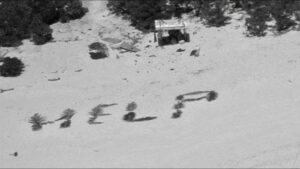United States Air Force pilot David Steeves went missing for 54 days. When he finally emerged, barely clothed, malnourished, and with slashes to his body, he recounted an astonishing tale of survival.
The crash
In 1957, the Air Force sent Steeves on a test flight from San Francisco to Alabama. He had already served as an air force pilot for two years. Colleagues considered him studious and dedicated, a model lieutenant.
Piloting a Lockheed T-33A Shooting Star Two-Seat Trainer, his short test flight started like any other. But shortly after take-off, catastrophe struck. “Something blew up,” Steeves later recounted.

Steeves’ T-33A aircraft crashed in the freezing Sierra Nevada Mountains.
Steeves blacked out. When he came to, his aircraft was spiraling out of control. Quick to react, he ejected with a parachute. Behind him, the T-33 exploded into pieces.
Steeves landed in dense trees in the Sierra Nevada Mountains. The rough landing left him with gashes to his body and two sprained ankles.
But surviving the plane crash was just the beginning.
In the Sierra Nevada
His clothes were shredded during his escape. All he had left to protect him from the elements was his parachute. Although it was May in California, he was 3,500m up in the mountains and dangerously exposed. At night, the weather went below freezing. All he could do was wrap himself in the parachute and shiver.
Steeves needed to find a way back to civilization quickly. Disoriented, he crawled for 15 days across more than 30km of rugged mountain terrain. He was near starvation.
Finally, Steeves finally had a stroke of luck. He came across an abandoned ranger’s cabin. Inside, he found canned beans, some ham, a pistol, a knife, and fish hooks.
Using the hooks, he caught fish. With the pistol, he shot a deer who was feeding at a salt lick. Regaining his strength, he attempted to walk out of the mountains. Instead, he almost drowned crossing the Kings River.
Wearing only his flight boots and tattered underpants, a group of people spotted him near Granite Basin. Fifty-three days after his plane crash, they carried Steeves out of the Sierra Nevada on horseback. He had lost over 18kg.
“My ankles are still swollen, otherwise I guess I’m okay,” Steeves told reporters a few days after his rescue.
Foul play?
Everyone had assumed Steeves was dead. His wife had already ordered his death certificate. At first, the public treated him like a hero. Here was a handsome pilot who had survived against all odds. But this changed when the Air Force couldn’t locate his crash site. The Air Force came to suspect that his story might be an elaborate coverup for selling his plane to the Soviets.
He lost his reputation, and he and his wife split up. His life was in tatters. For years, Steeves attempted to clear his name. He rented small planes and crisscrossed the mountain range in search of his wreckage. But he found nothing.
Just eight years after the first, in 1965, Steeves was in another plane crash. This time he was not so lucky. He died in the crash, aged just 31.
In 1977, a group of Boy Scouts came across a broken airplane part while hiking in Kings Canyon National Park. The serial number matched the missing T-33A that Steeves had piloted. Too late, Steeves was finally vindicated.






